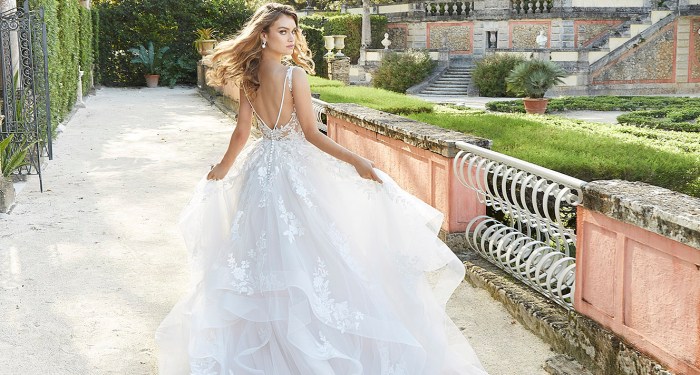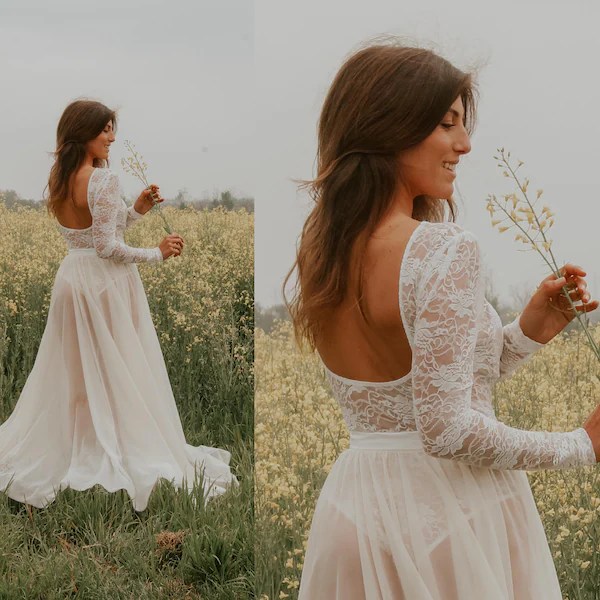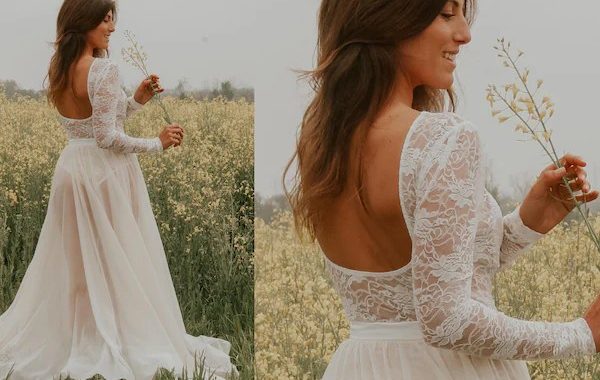Defining the “Fairy Garden” Aesthetic
Fairy garden wedding dresses – The fairy garden aesthetic in wedding attire evokes a sense of whimsical romance and natural beauty. It draws inspiration from the enchanting imagery of miniature gardens, incorporating elements of delicate flowers, flowing fabrics, and natural textures to create a look that is both ethereal and elegant.
Key Visual Elements
Key visual elements defining a fairy garden aesthetic include soft, pastel color palettes, delicate floral appliqués, flowing fabrics like silk chiffon or tulle, and natural textures such as lace, embroidery, and even subtle touches of greenery or vines woven into the design. The overall effect is one of effortless charm and romantic whimsy.
Color Palettes
Common color palettes for fairy garden weddings include soft pastels like blush pink, lavender, mint green, and ivory, often accented with deeper jewel tones like emerald green or rose gold for contrast. These colors create a harmonious blend of delicate hues that reflect the natural beauty of a fairy garden.
Fabrics and Textures
Fairy garden-inspired dresses often utilize lightweight, flowing fabrics such as silk chiffon, tulle, organza, and lace. These fabrics create a sense of ethereal movement and delicacy. Textures are key; delicate embroidery, floral appliqués, and subtle beading add depth and visual interest, mimicking the intricate details found in nature.
Fairy Garden Wedding Dress Styles
| Style | Silhouette | Details | Suitable for |
|---|---|---|---|
| Bohemian | A-line, flowy | Lace, embroidery, floral appliqués, flowing sleeves | Most body types |
| Romantic | Ballgown, fit-and-flare | Tulle, delicate beading, illusion neckline, long train | Hourglass, pear |
| Whimsical | Short, tea-length | Unique embellishments, playful details, unexpected colors | Petite, athletic |
| Classic | Sheath, mermaid | Clean lines, simple embellishments, high-quality fabric | Most body types |
Dress Design Elements
The details are crucial in achieving the fairy garden aesthetic. Careful consideration of floral appliqués, natural elements, neckline, and sleeve styles contribute to the overall effect.
Floral Appliqués and Embroidery
Floral appliqués and embroidery are integral to the fairy garden aesthetic. Delicate floral patterns, meticulously crafted in 3D or embroidered onto the fabric, add a touch of whimsical romance. These details can be strategically placed to accentuate the dress’s silhouette and create a sense of movement and fluidity.
Incorporation of Natural Elements
The incorporation of natural elements like vines, leaves, and feathers adds a touch of organic beauty. These elements can be subtly woven into the design, creating a seamless blend of nature and artistry. For example, delicate vine embroidery could accentuate the neckline or waistline, while small feather details could add a touch of ethereal lightness.
Neckline Options
Three neckline options ideal for a fairy garden wedding dress include: a sweetheart neckline, flattering on most body types; a V-neckline, which elongates the torso; and an off-the-shoulder neckline, which adds a touch of romance and is suitable for those with broad shoulders.
Sleeve Styles, Fairy garden wedding dresses
Sleeve styles that complement the fairy garden theme include flutter sleeves, which add a touch of whimsy; bell sleeves, which create a romantic and flowing silhouette; and off-the-shoulder sleeves, which offer a delicate and feminine touch.
Accessories and Styling: Fairy Garden Wedding Dresses
Accessories play a crucial role in completing the fairy garden wedding look. Careful selection of headpieces, jewelry, and veils enhances the overall aesthetic.
Headpiece Options
Three distinct headpiece options include: a floral crown, crafted from fresh or artificial flowers; a delicate hair vine, adorned with pearls or crystals; and a jeweled headband, adding a touch of sparkle and elegance.
Complementary Jewelry
Jewelry should complement the dress without overpowering it. Delicate necklaces, earrings, and bracelets featuring natural elements like pearls, crystals, or wildflowers are ideal choices. Avoid overly ornate or heavy pieces.
Veil Styles
- Birdcage veil
- Mantilla veil
- Shoulder-length veil
- Cathedral-length veil
- Elbow-length veil
Fairy Garden Wedding Bouquet
A fairy garden wedding bouquet should incorporate a variety of delicate flowers and foliage. Consider using wildflowers, roses, lavender, and greenery such as eucalyptus or ferns. The bouquet should be loosely arranged, creating a natural and whimsical look.
Real-World Examples and Inspirations
Observing real-world examples provides valuable insights into the diverse interpretations of the fairy garden aesthetic.
Real Fairy Garden Wedding Dresses
Dress 1: A flowing A-line gown in ivory silk chiffon, adorned with delicate floral appliqués and a scattered pearl embellishment. The dress featured a sweetheart neckline and flutter sleeves. The bride paired it with a floral crown and a cathedral-length veil.
Dress 2: A romantic ballgown in blush pink tulle, with intricate beading and a delicate lace overlay. The dress featured a fitted bodice and a full skirt. The bride wore a jeweled headband and carried a bouquet of pastel roses.
Dress 3: A whimsical tea-length dress in mint green organza, with unique floral embroidery and a playful bow at the waist. The dress featured a V-neckline and short sleeves. The bride wore a simple hair vine and carried a bouquet of wildflowers.
Dress 4: A classic sheath gown in ivory silk crepe, with clean lines and minimal embellishments. The dress featured a high neckline and long sleeves. The bride paired it with a simple pearl necklace and a birdcage veil.
Dress 5: A bohemian-style gown in ivory lace, with intricate embroidery and a flowing skirt. The dress featured a halter neckline and long sleeves. The bride wore a floral crown and carried a bouquet of wildflowers and greenery.
Designer Dress Comparisons
Comparing dresses from different designers reveals variations in interpretation. For instance, one designer might emphasize intricate embroidery, while another might focus on the use of natural elements. These variations showcase the versatility of the fairy garden aesthetic.
Lighting and Venue Considerations
Lighting conditions significantly impact the appearance of a fairy garden wedding dress. Outdoor lighting can enhance the delicate details and colors, while indoor lighting may require adjustments to ensure the dress is appropriately showcased. The venue also plays a role; a forest setting complements the natural theme better than a modern ballroom.
Styling for Different Venues
Styling a fairy garden wedding dress for different venues requires adapting the accessories and overall look. A forest setting might call for more rustic accessories, while a garden venue could allow for a more refined look. A barn setting might benefit from a more relaxed, bohemian approach.
Variations on the Theme

Source: cloudfront.net
The fairy garden theme offers considerable scope for personalization and creative exploration.
Cultural Influences
Incorporating cultural influences can add unique depth to a fairy garden wedding dress. For example, incorporating traditional embroidery techniques from a specific region or using fabrics with cultural significance can personalize the design.
Personalization
Personalizing a fairy garden wedding dress can be achieved through unique embellishments, custom embroidery, or incorporating elements that reflect the bride’s personality and interests. This ensures the dress is truly unique and meaningful.
Sustainable Materials
Using sustainable and eco-friendly materials, such as organic cotton, recycled lace, or ethically sourced silk, aligns with the natural aesthetic of a fairy garden theme and promotes environmentally conscious practices.
Seasonal Adaptations

Source: etsystatic.com
Adapting the fairy garden theme for different seasons involves adjusting the color palette and fabrics. For example, a spring wedding might feature lighter pastels and flowing fabrics, while an autumn wedding might incorporate richer jewel tones and heavier fabrics.
FAQ Guide
What is the best season for a fairy garden wedding?
Spring and summer are ideal, showcasing the vibrancy of flowers and foliage, but the theme can be adapted for autumn with warm tones and rich textures.
How can I incorporate my personality into a fairy garden wedding dress?
Personalization can be achieved through unique embroidery, specific color choices, or the incorporation of meaningful accessories reflecting your hobbies or interests.
Are there budget-friendly options for fairy garden wedding dresses?
Yes, many designers offer beautiful, affordable options. Consider renting a dress, choosing simpler fabrics, or focusing on impactful accessories instead of elaborate embellishments.
Where can I find inspiration for fairy garden wedding dresses?
Browse bridal magazines, Pinterest, Instagram, and wedding blogs for ideas. Look at designers specializing in romantic or bohemian styles.

